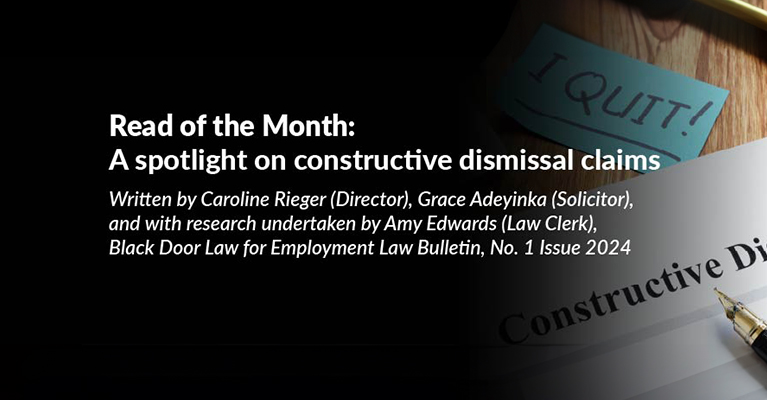Summary The year legal AI became real Voices shaping the profession A year worth remembering Contributors 2025 There's a curious phenomenon about how we experience time. When our days are...
Summary The problem with platform hopping How the models differ Security without compromise Beyond legal research The speed of adoption Originally published by NZ Lawyer . Republished...
Summary Introducing Protégé General AI General AI Models Available in Protégé for New Zealand Legal Workflows Practical Use Cases for Lawyers But as AI becomes more common in legal practice...
Summary The efficiency revolution Levelling the playing field Managing the transition carefully Specialised practice applications The evolution of legal service delivery Maintaining quality...
Summary The best in-house lawyers are pragmatic in a crisis Invest in your worst-case scenario In today’s fast-paced media environment, corporate crises demand swift, coordinated responses...

Summary
- What is constructive dismissal?
- The legal threshold
- Types of constructive dismissals
- The law of constructive dismissal in practice
- In our view
- Conclusion
Copyright of the Employment Law Bulletin is the property of LexisNexis NZ Ltd and its content may not be copied, saved or emailed to multiple sites or posted to a listserv without the copyright holder's express written permission.
However, users may print, download or email articles for individual use.
Written by Caroline Rieger (Director), Grace Adeyinka (Solicitor), and with research undertaken by Amy Edwards (Law Clerk), Black Door Law for Employment Law Bulletin, No. 1 Issue 2024
What is constructive dismissal?
Constructive dismissal is an often misunderstood concept in employment law. It is often misused to describe situations where an employee resigns or wishes to resign as a result of difficult circumstances in the workplace. However, constructive dismissal refers to a situation where, as a result of an employer’s action or inaction, an employee’s job or workplace becomes untenable, and they have no other option but to resign.
The legal threshold
Constructive dismissal claims are difficult to prove. The legal threshold for a constructive dismissal claim is significantly higher than other dismissal claims. In contrast to other dismissal claims, the employee has the evidential burden for a personal grievance claim in constructive dismissal under s 103(1)(a) of the Employment Relations Act 2000.
Types of constructive dismissals
In the case of Auckland Shop Employees IUOW v Woolworths (NZ) Ltd,1 the Court of Appeal clearly set out the three major categories (these categories are not exhaustive) of constructive dismissal claims including:2
- the employee was given no option but to resign; or
- the employer followed a course of conduct with the deliberate and dominant purpose of coercing an employee to resign; or
- the employer breached their statutory duty of good faith or employment agreement, causing the employee to resign.
The first category of constructive dismissal case is where an employer gives an employee an option of resigning or being dismissed.
The second category of constructive dismissal is where an employer has followed a course of conduct with the deliberate and dominant purpose of coercing an employee to resign. The Employment Court in Chief of New Zealand Defence Force v Darnley3 held that the employer must intend to coerce the employee through a “conscious decision to act in a way that will procure a resignation”.
The third category of constructive dismissal is where a breach of duty by the employer leads an employee to resign. Unlike the second category, intent is not a requirement. However, the employer’s breach must be so serious as to reasonably cause the employee to believe they could not perform their obligations. Serious conduct has been defined as more than mere inconsideration or causative of unhappiness; it must be repudiatory. The breach must also be so serious that it was reasonably foreseeable to the employer that the employee would resign.
The law of constructive dismissal in practice
A number of recent cases have shed light on some of the complexities of constructive dismissal claims and from these cases, we have observed some clear patterns which we think are interesting and useful to know, particularly when it comes to identifying key factors that contribute to the success or failure of constructive dismissal cases.
From our research, constructive dismissal was claimed in 60 cases in the Employment Relations Authority (ERA) and one case in the Employment Court where determinations were issued between January 2023 – January 2024. From these cases, we found the following:
- The majority of the cases that were successful fell within the breach of good faith or contractual obligations category.
- Very few claims based solely on the argument that the employer had followed a course of conduct with the deliberate and dominant purpose of coercing the employee to resign were successful. We suspect this may have been because of the significant requirement that the employee has to prove that the employer intentionally coerced the employee to resign.
- The most common determinative factor in the cases we studied was the employer’s intentional breach of their good faith obligations. We found that in cases where the employee had raised a personal grievance with their employer either formally or informally, if they were met with inaction, often the employer would be considered to have acted in bad faith. For example, in McLellan v Priory in New Zealand of Most Venerable Order of Hospital of St John of Jerusalem (t/as St John’s Ambulance), McLellan made many attempts to make his work-related stress known to his employer but was continuously met with inaction.4 In Burn v TSP Construction Ltd, a more extreme example, where the employer made a “totally improper attempt to coerce [the employee] into dropping [their] legitimate personal grievance or face potentially serious consequences” which the Authority categorised as blackmail.5 In these cases, the employer’s intentional refusal to respond appropriately meant it was foreseeable their actions would cause a resignation.
- In cases where the employee was not explicit with their employer about their concerns, it was harder for the claim to meet the foreseeability threshold. This is because unless the employer is aware of the impact of their action or inaction on the employee, they do not have a reasonable opportunity to resolve the grievance. In Holly Bell (née) Melville v Inkdrop Ltd, the employee raised concerns in a series of emails to her manager that she was being overworked. However, the ERA held that her emails to her manager sent “mixed messages” — for example, in one of the employee’s emails, she stated “happy to stay late on Thursdays” and that she is “always available to help”.6 It was held that the employee’s emails could have been clearer and put the employer on notice that working in excess of her usual hours was impacting her personal and social life. The ERA concluded that the claim of constructive unjustified dismissal was not made out. The Holly Bell (née) Melville case suggests that in order for the cases under the third category of constructive dismissal claims to be successful, the employee must have exhausted all opportunities to clearly communicate their concerns.7
- There is an exception to the general rule of notifying the employer in constructive dismissal cases where there has been a breach of good faith so serious as to diminish the trust and confidence of the employment relationship and cause resignation. This was particularly evident in cases where the employee had been verbally abused.8
- If an employee raises concerns with an employer but resigns before the employer can resolve the matter, the resignation is more likely to be seen as a free decision. In Harte v Te Whatu Ora — Health New Zealand, the employer launched an investigation in response to the employees’ grievances, but before a conclusion could be reached the employee resigned.9 If the employer in cases like Harte can demonstrate that they expressed an intention to resolve the issues to the employee, and such a resolution is possible, the resignation could be considered premature.
- Where the employer made blatant breaches of the employment agreement, the need for the employee to notify the employer diminished. To breach a contract in and of itself is serious enough to foreseeably cause a resignation. These breaches have included the employer withholding pay and the employment agreement, as well as breaching the Holidays Act 2003.10 The degree of “seriousness” is more unclear for conduct accused of being in bad faith.
- An employee must prove that the employer’s conduct caused them to resign. Where there is more than one reason for the employee’s resignation, the determinative reason crystallising the resignation must be attributable to the employer. In Simpson v Hoff-Nielsen,11 the employee initially attributed his resignation to the hours, financial stress and debts owed to him by his employer. However, later in an interview, he clarified that the primary reason for his resignation was that his family wanted to move away from their neighbour’s domestic violence. Due to the employer having no control over the domestic violence issue, it was held that the test of foreseeability was not met, and no breach of duty occurred attributable to the resignation. In the Employment Court of Ling v Super Cuisine Group Ltd,12 the employee successfully challenged the Employment Relations Authority determination and the Court found that the employee had been constructively dismissed on the basis that the ERA failed to take into consideration that the employee’s resignation was caused by the employee’s breach of its duty to correctly pay him for all hours worked. The Employment Court held that the employee had been constructively dismissed on the basis that the employee’s breach had caused the employee to resign, and the employee’s resignation was reasonably foreseeable.
In our view
The cases we have discussed in this article highlight how complex and challenging constructive dismissal claims are for employees to prove. This is primarily due to the fact that the onus is on the employee to prove that as a result of the employer’s action or inaction, they were left with no other option but to resign.
Given how difficult constructive dismissal claims are to prove, a starting point for assessing a claim could be:
- has the employee actually resigned from their employment;
- the nature of the employer’s alleged conduct, which led to the employee resigning;
- how soon after the employer’s conduct did the employee resign. The timing of an employee’s resignation relative to the employer’s conduct is likely to strengthen the argument that the employer’s actions caused and was sufficiently serious enough to justify the employee’s decision to resign;
- the steps taken by the employee before resigning;
- the impact of the employer’s conduct on the employee;
- whether the employee’s conduct has contributed towards the constructive dismissal; and
- whether the employer can prove that their action was justified or reasonable.
Conclusion
Although we were unable to obtain actual statistics regarding the success rate of constructive dismissal claims in New Zealand, the cases we have studied suggests that the rate is quite low. As noted previously, this is primarily due to the fact that the burden of proof placed on the employee is relatively high and often cannot be met. Accordingly, employees should view resigning and claiming constructive dismissal as a last resort remedy that should only be exercised after all other avenues of resolution have been exhausted and after complying with their employer’s grievance and disciplinary process.
This article is part of Employment Law Bulletin No.1 issue, 2024. The Employment Law Bulletin keeps you up to date with the latest developments in employment law and is a must for any practitioner or professional dealing with employment law issues. The Bulletin is highly regarded among practitioners and stakeholders in the employment field, including the Courts. Each issue contains articles giving expert practical analysis on the most current and relevant issues in employment law, Q & As with leaders in the employment law field, as well as case notes on key employment decisions.
General Editor Susan Hornsby-Geluk, one of New Zealand’s leading employment lawyers, directs the Employment Law Bulletin content and ensures a practical focus.
To enquire about Employment Law Bulletin subscription, submit the form below:
- Auckland Shop Employees IUOW v Woolworths (NZ) Ltd [1985] 2 NZLR 372 (CA).
- Above; and Auckland Shop Employees IUOW (Industrial Union of Workers) v Woolworths (1985) ERNZ Sel Case 136 at [139].
- Chief of New Zealand Defence Force v Darnley [2022] NZEmpC 4.
- McLellan v Priory in New Zealand of Most Venerable Order of Hospital of St John of Jerusalem (t/a St Johns Ambulance) [2023] NZERA 495 at [49].
- Burn v TSP Construction Ltd [2024] NZERA 10 at [80].
- Holly Bell (née) Melville v Inkdrop Ltd [2023] NZERA 533 at [93] and [94].
- Harrod v DMG World Media (NZ) Ltd [2002] 2 ERNZ 410 (EmpC) at [54].
- Lee v Gary Chen Electrical Ltd [2023] NZERA 746 at [44].
- Harte v Te Whatu Ora — Health New Zealand [2023] NZERA 421at [147].
- Choi v HSK Ltd (t/as Five Star Restaurant) [2023] NZERA 593 at [37]; and Shanks v Thomas (t/as Te Matai Partnership) [2023] NZERA 585 at [70].
- Simpson v Hoff-Nielsen [2023] NZERA 747.
- Ling v Super Cuisine Group Ltd [2023] NZEmpC 106 at [54].





